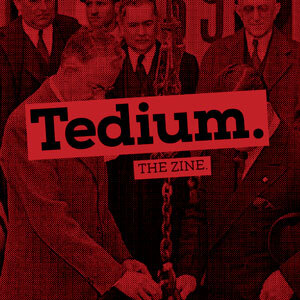Hey all, Ernie here with a piece from Andrew Egan, who has—for reasons he’ll explain in the piece—seen the movie Forrest Gump literally dozens of times in the past few weeks, mostly in passing. It gives him a particularly unique vantage point to the film’s 25th anniversary.
Today in Tedium: Ask an average person to list things to see in New York City and you’ll probably get the average list: the Statue of Liberty, The Empire State Building, One World Trade Center. The most “iconic” location in the city is one that many tourists head to first, Times Square. The history of Times Square is fascinating and well tread territory. But if you stand in the chaos at 44th and Broadway, you might find yourself asking yourself a weird question. Today’s Tedium asks: How did a restaurant based on a 25-year-old movie became one of the busiest in the nation? — Andrew @ Tedium
Last chance for a zine: The third issue of the zine is (finally) done! The only thing that’s missing is your name on the back page. Want a copy? Support us on Patreon at a $5 level or above ($8 for international) by midnight Saturday to get in before the deadline. Time is running out—so act now!
380k
The number of pedestrians that enter Times Square on any given day. This number varies at any given moment or day. In fact, estimating the crowd size in Times Square is a strangely political practice in New York. Politicians routinely inflate crowd sizes beyond what experts say happened or is even possible. (It’s probably worth doing a Tedium article all its own.)
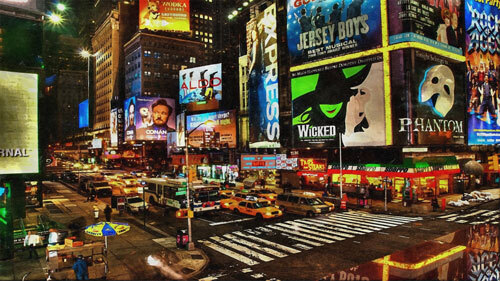
Times Square today. (via Pixabay)
Times Square’s gradual evolution: From seedy streets to family eats
For quite a while in the post-war period, Times Square was less the crossroads of civilization and more of a place to score porn before it was acceptable.
Combating the sleaze that gradually swallowed Times Square is a rare kind of history, shaped by obscure city ordinances and zoning laws. One of the most impactful was actually started under the Ed Koch administration, then picked up during the administration of David Dinkins. By rezoning sex stores to require a minimum distance between them, politicians had begun the slow process of cleaning up Times Square. They also started condemning problem properties and recruited developers to attract high-end retailers.

Times Square circa 1960. We’d show you what it looked like during the 1970s, but Tedium is a family publication. (Wikimedia Commons)
Perhaps the single greatest effect on modern Times Square happened in 1995 when the theatrical wing of Disney moved into the New Amsterdam theater in 1995 on a 49-year lease. This seemed to spark a series of changes that transformed the area pretty quickly after. The Harem, a pornographic theater at 42nd St., shut down. Today, it’s a Regal Cinema.
By the early 2000s, America’s former favorite mayor, Rudy Giuliani, had continued his predecessors’ work, helping transform NYC and Times Square specifically into ultra-sanitized versions of themselves. With the family friendly attractions, parents started to bring their kids back. Now, Times Square is so kid oriented that “performers” dress in costumes of family characters and offer to take pictures dressed as Hello Kitty, the Statue of Liberty, and of course weird-looking Elmo’s. Oh, and they get super mad if you take their picture and don’t tip/pay.
But enough about Times Square’s admittedly interesting history; if I’m honest, I’m delaying. I’m delaying because I have to talk about a restaurant that defies logic, let alone description.
For those who are not aware, there is a chain of some 30 restaurants around the globe based on the 1994 Academy Award winner for Best Picture, Forrest Gump.
Why couldn’t they have just gone with Jack Rabbit Slim’s?
$14M
The amount of revenue generated by the Times Square location of the Bubba Gump Shrimp Company in 2005, according to a New York Magazine article. Those numbers are still pretty high today, if the plaques in the back of the restaurant are to be believed. Sales in 2016 hit some $16 million, which makes Bubba Gump Times Square one of the busiest restaurants in the U.S., though next door neighbor Carmine’s is the actual king of Times Square, having made $35 million and serving nearly 400,000 meals.
“Shrimp is the fruit of the sea.”
How a bizarre pitch from movie executives led to an international restaurant chain
Before I even talk about the story of how a movie themed restaurant based on Forrest Gump became a reality, it needs to be pointed out that the founder of the chain wrote a book about the experience that is called … sigh … Gumption: Taking Bubba Gump from Movie to Restaurant.
A questioning attitude toward the concept of a Forrest Gump-themed restaurant is not unwarranted. Even one of the founders freely admits they had no idea what to do with the concept when approached by executives at Paramount Pictures in 1995. The movie—which featured a successful shrimp company named after Gump (an Oscar-winning role for Tom Hanks) and a beloved shrimp-loving soldier named Benjamin Buford “Bubba” Blue (played by Mykelti Williamson)—had been a smash success, but other than home video sales and cable licensing, revenue streams were limited. So, someone at Paramount had an idea.
They approached Scott Barnett, an executive with Rusty Pelican Restaurants, which was then focused on American cuisine and seafood. In an interview to support his book, Barnett explained his mixed reaction to being approached by Paramount executives, “We told them ‘Great idea!’ Actually, we had no idea how it would go—but beggars can’t be choosers.”
(One thing that helped their chances: This period was a particularly strong one for theme restaurants—the Hard Rock Cafe was well into its global expansion during this period, and the ’90s saw a number of other well-known theme chains, such as Planet Hollywood and Rainforest Cafe, come to life.)
An unconventional concept requires an unconventional approach. For example, rather than create unique recipes that reflect the movie, then coming up with marketable names for them, Barnett and his team did the opposite. They named the dishes before actually creating them.
To a degree this makes sense. With a beloved movie, the team had a chance to craft a dining experience around its themes and characters. In a podcast, Barnett said, “If [the customers] enjoyed the dining experience and thought it relatable to the movie, he would have a winner.”
This led to things like Jenny’s Catch, Mama Blue’s Southern Fried Shrimp, and, uh, Bubba’s Far Out Dip.
The first Bubba Gump opened in Monterey, California in 1996 and eventually grew to more than 30 locations, usually in well known tourist areas.
In 2010, the company was acquired by restaurant conglomerate Landry’s for an undisclosed sum. Barnett left shortly after. Yet the strange stories associated with Bubba Gump continue. Former network schlub turned A-List superhero Chris Pratt was discovered while working as a waiter at a Bubba Gump in Hawaii.
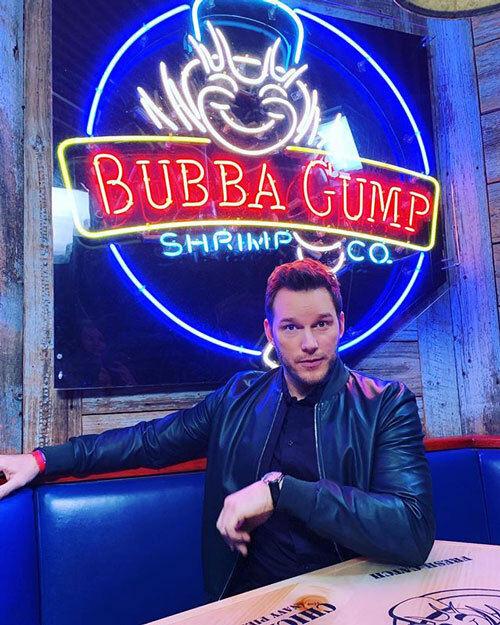
The second-most-famous actor associated with Bubba Gump Shrimp Company. (via Instagram)
On Instagram, Pratt once wrote, “Every time I go back I’m reminded of the thousands of shrimp I ate off of people’s plates on the way back to the kitchen.” Dude, ew. But it’s interesting to know we have something in common.
“Take my word for it—don’t never let nobody make a movie of your life’s story. Whether they get it right or wrong, it don’t matter.”
— A quote from Forrest Gump from the 1995 book Gump & Co., the “sequel” to the book that inspired the movie. The author, Winston Groom, had a famously prickly relationship with the film adaptation of his most famous book. Famously, he had to sue to get his 3 percent cut of the profits from the film, after being told that the film, one of the biggest hits of 1994, wasn’t profitable. There was, to put it lightly, always a gap between the film and source material. The book involved Forrest going to space with an orangutan. Throughout the book, he also maintains an active sex life with multiple women. It’s a very, very different book.
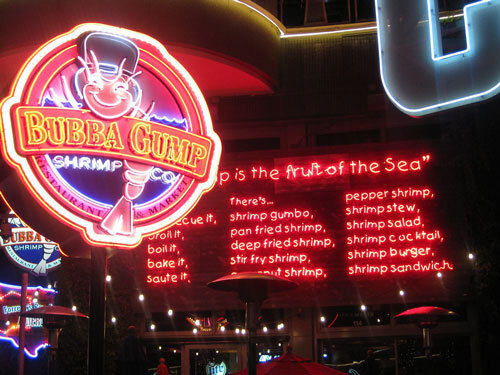
(Bruno Sanchez-Andrade Nuño/Flickr)
A day waiting tables at Bubba Gump Shrimp Company
It’s Saturday, July 6th, 2019. Other than being a Saturday night in one of the busiest intersections in the world, this date has importance for Bubba Gump Shrimp Times Square. Twenty five years ago that day, the film Forrest Gump debuted in theaters. Along with pictures from the movie adorning the walls and an occasional appearance by an actual Forrest Gump impersonator, servers at Bubba Gump are required to ask their tables Forrest Gump themed trivia. I know this, along other neat details because I was working as a waiter at Bubba Gump on that auspicious day.

It’s a place that serves shrimp in Times Square. Of course people go there. (Bubba Gump Shrimp Company)
I hadn’t been in the position for very long but it quickly became clear that the cultural impact of the film has waned in recent years. A good number of tables, many of them foreign tourists with limited English language ability, shrugged when asked about the movie. They were simply in Times Square and saw a place that served shrimp. It’s understandable.
I have worked in restaurants off and on for my entire adult life. I have worked in over a dozen restaurants across two states and three cities. I have worked during rush hour in state capitals and big cities. I have seen a midtown Manhattan restaurant packed and on a wait with too few servers to tend to them. I say this so that when I say that Times Square will redefine any industry veteran’s idea of busy, you’ll believe me. Wait times can hit an hour and a half with more people lining up behind them. Frustration and exhaustion seem to cling to customers and staff alike.
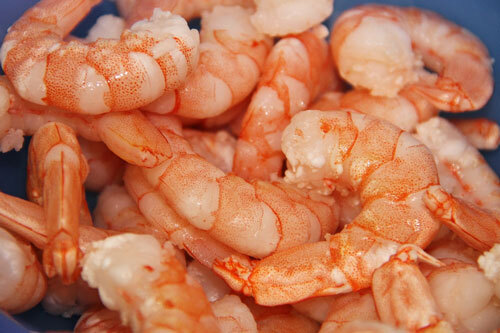
(via Pixabay)
If you think any of this is hyperbole or exaggeration, I’m not alone. New York writers have long documented the horrors of working in Times Square. Jezebel recently moved in and has been releasing articles about dystopian visits to the Hershey store and lonely dining at Planet Hollywood. The king of attention in this weird category, however, is the Olive Garden which seems to get a lot of writers asking, “who eats at the Olive Garden in NYC?” A lot of people, it turns out. Managing the restaurant is no easy feat as an Intelligencer article noted “when it comes to running the busiest Olive Garden in the world, running out of breadsticks is more harrowing than two customers getting into a knife fight.”
Working in a Times Square restaurant is quite bizarre, more akin to working an amusement park concession stand than the typical American dining experience. The kitchen at Bubba Gump is massive and could probably feed a literal army. Repeat business is virtually nonexistent, unless tourists really love the food and come back multiple times during their stay. (Which actually does happen sometimes.)
This particular Saturday night was busy, but not by Times Square standards. Management was also worried there would be an influx of Forrest Gump devotees that’d slam the restaurant with requests and a desire for a more intimate experience. (This did not happen. There is a stock version of the film playing on continuous loop, which is done daily, but the restaurant did nothing special to commemorate the film other than, you know, existing.)
Saturday nights are long shifts lasting some nine hours with a half hour break. There’s no guarantee the night will be financially rewarding but it often works out to a fairly decent wage. For the most part, the customers are like any others. And Saturday night customers are notoriously awful. Loud shouting matches in the dining room between customers. Various forms of intoxication. Out of control children. Sometimes that can all be at just one table. Bystanders next to offending tables ask to move but there’s nowhere to put them.
Anyone that has ever worked in a restaurant knows they can be volatile places. Tensions are often tight. Customers can be difficult and there are a lot of them. Add to these typical industry issues is another element of Times Square restaurants that people notice but underestimate. They are all almost absurdly large, some of the biggest restaurants in NYC are in Times Square. Going from the kitchen to the furthest point in the restaurant is basically the equivalent of walking one city block per trip. Coworkers that have worn pedometers while working have said they’ve walked up to ten miles in an eight hour shift. The size of the restaurant also means you have a lot of coworkers. There are some 20 to 30 working on any given night. So a lot of different personalities coming together in a cramped but large space. What could go wrong?
I was thinking about detailing that night here in its entirety, including all the kitchen gossip, but that seemed petty. Ultimately, it’s a difficult job and the people that do it are just trying to get through the day. And it’s not for me. I’ll figure something else out.
To put an overall description to my brief time in Times Square: I’ve had a lot of crazy experiences in the restaurant industry, and I’ve heard many more from coworkers over the years. After just a few weeks in Times Square, I could top them all.
Most restaurants are professional pit stops, but a few grow on you. This one didn’t, and I find myself joining the brigade questioning the reason Times Square exists other than money. From the inside, however, I’m asking a very different question: Why would anyone do this for a living? Oh yeah, money.
On a closing note, to anyone that works or may find themselves paying rent by serving people shrimp, just one piece of advice: Don’t eat leftovers from a customer’s plate.
(Ew.)
--
Find this one an interesting read? Share it with a pal! And thanks again to Andrew for talking about one of his weirdest jobs ever.
